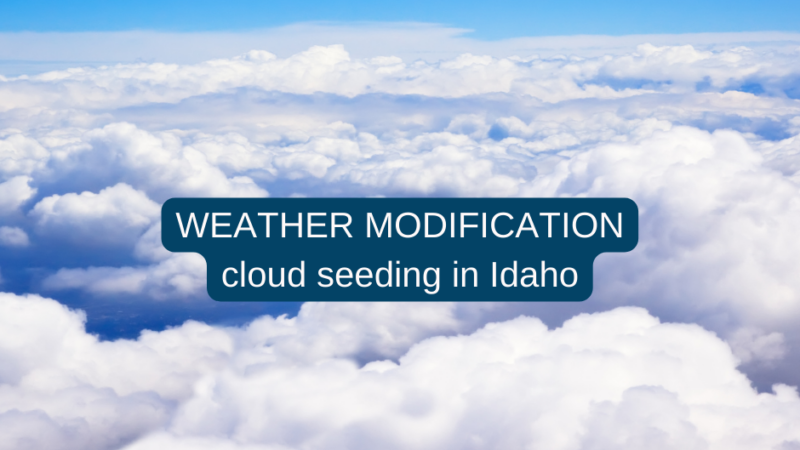Cloud Seeding One Big Dangerous Experiment
Cloud seeding is a weather modification scheme that has been around for years. Many water resources departments refused to advertise the program until legislation was passed, giving them authority over the operation and special liability protections. Locally, these protections cover Idaho Department of Water Resources (IDWR) as well as the state contracted private company/s spraying cloud-seeding particulates into our skies. Unfortunately, the Idaho legislature passed HB266 in 2021, granting IDWR complete control of cloud seeding operations. Under this bill, IDWR and their contractors can operate the program with no permit required and no recourse for citizens, farmers, or anyone else negatively impacted by the experimental program. Concerningly, the bill states, “Chapter 43, Title 42, Idaho Code: (5) The act of cloud seeding pursuant to a project funded in whole or in part by the state of Idaho or authorized by the state water resource board shall not be the basis of any claim of liability, including but not limited to trespass or public or private nuisance, and shall not require any state or local permits.” Many citizens and small farmers are asking why IDWR required such broad protections. A farmer or rancher could be gravely impacted by human error while cloud seeding – overseeding could lead to flooding or applying too much chemical could lead to crop loss. The burden is unreasonably placed on the citizen.
Does it work?
The science is dubious, at best. As programs fail to prove the efficacy and safety of cloud seeding, the proponents of weather modification shift their focus from one failed program to a new program, usually proven through computer modeling. The Wyoming Weather Modification Pilot Project program was a model used to support cloud seeding programs but failed to show statistically significant results. Reportedly, “analysis showed that cloud seeding produced a 3 percent increase in precipitation with a 28 percent probability that this result happened by chance. Most scientists and statisticians wouldn’t accept that level of uncertainty, says Breed, [a meteorologist at the National Center for Atmospheric Research].” The Wyoming program is currently under pressure to pull back funding for the cloud seeding program. In February 2023, several legislators in Wyoming decided the cloud seeding data was unproven and funding should not continue. “State Sen. Bo Biteman, R-Ranchester, proposed an amendment to an omnibus water bill that would have eliminated nearly all state funding for the program…The amendment was defeated on a 18-13 vote.” In a recent email with Julie Gondzar, Weather Modification Program Manager in Wyoming, regarding the likelihood of IDWR potentially partnering with Wyoming in cloud seeding funding, she commented that, “[the] Wyoming program is under a lot of pressure from the Wyoming Legislature to cut back.” Final approval of program funding will not be voted on until January or February of the upcoming legislative session.
With unproven results in Wyoming, Idaho shifted its focus to their own local experimentation on the Payette Basin. The SNOWIE (Seeded and Natural Orographic Wintertime Clouds — the Idaho Experiment) project is the new frontier of more unverified cloud seeding programs. The project is described as, “SNOWIE used supercomputing technology to develop a new computer model to simulate cloud seeding, as well as new measurement capabilities, such as a high-resolution cloud radar on a Wyoming research aircraft that can see previously invisible cloud features.” Furthermore, studies cite minimal success in forcing precipitation from clouds, “[a] cloud-seeding flight on Jan. 19, 2017, that generated snow for 67 minutes, dusting about 900 square miles with a tenth of a millimeter of snow beyond what was falling naturally.” Perhaps these results are perceived to be good in a computer modeling analysis, but citizens have to wonder what the real-world risk/reward trade off is.
Is it safe?
The researchers admit that isolating a control group is very difficult with cross-wind contamination and other natural factors. NOAA (National Oceanic and Atmospheric Administration) requires that cloud seeding operators submit a form notifying the department of planned cloud seeding experiments. The form allows the operator to insert a date range (no limit to duration of range; could be months or years in length) and a description of “modification agents.” The reported amount of silver iodide applied continues to increase each year and many previously disclosed chemicals are now left off of the NOAA form. Upon asking NOAA to clarify if cloud seeding operators need only disclose those chemicals which modify the clouds/weather or all agents used, NOAA responded, “When in doubt, please include all!” I believe that it is not only possible, but likely cloud seeding operators are taking advantage of NOAA’s lax reporting requirements, leaving some previously disclosed chemicals off their reports in recent years. A report filed by Marty and Conni Owen in eastern Idaho for the period 12/20/1999-4/30/2000 shows “ground based generators… used silver iodide, ammonium iodide, acetone. Application rate of silver iodide, 7-12 grams per hour.” However, the Owens’ recent reports only include silver iodide and in greater quantities than in previous years. A more recent report filed for 11/01/2022-05/31/2023 shows, “ground based generators and a propane gas supply. Silver iodide is used as the weather modification agent at a rate of 20 grams per hour.” There are many issues with both these reporting concerns. How much silver iodide is too much and what are the accumulative effects? Upon asking the IDWR department for past historical water tests monitoring chemical levels in water before and after cloud seeding, the department responded, “The Idaho Water Resource Board and Idaho Department of Water Resources do not test or maintain records of water quality tests of rainwater.”
One big (dangerous) experiment
Lastly, why is IDWR stating in presentations that they look for “opportunities for seeding with propane” in recent meetings? As seen in the NOAA report referenced above, it is clear that propane is currently used in cloud seeding operations. It probably goes without mentioning, but propane is extremely flammable. With risk should come responsibility. IDWR and their partners cannot continue experimenting. IDWR and their stakeholders should provide proof of effectiveness and safety. Dates of seeding should be discrete and specific to allow citizens, farmers, and interested parties the opportunity to assess the results. If these modest requirements are adopted, IDWR and their contractors will not need the special liability protections they currently enjoy.





